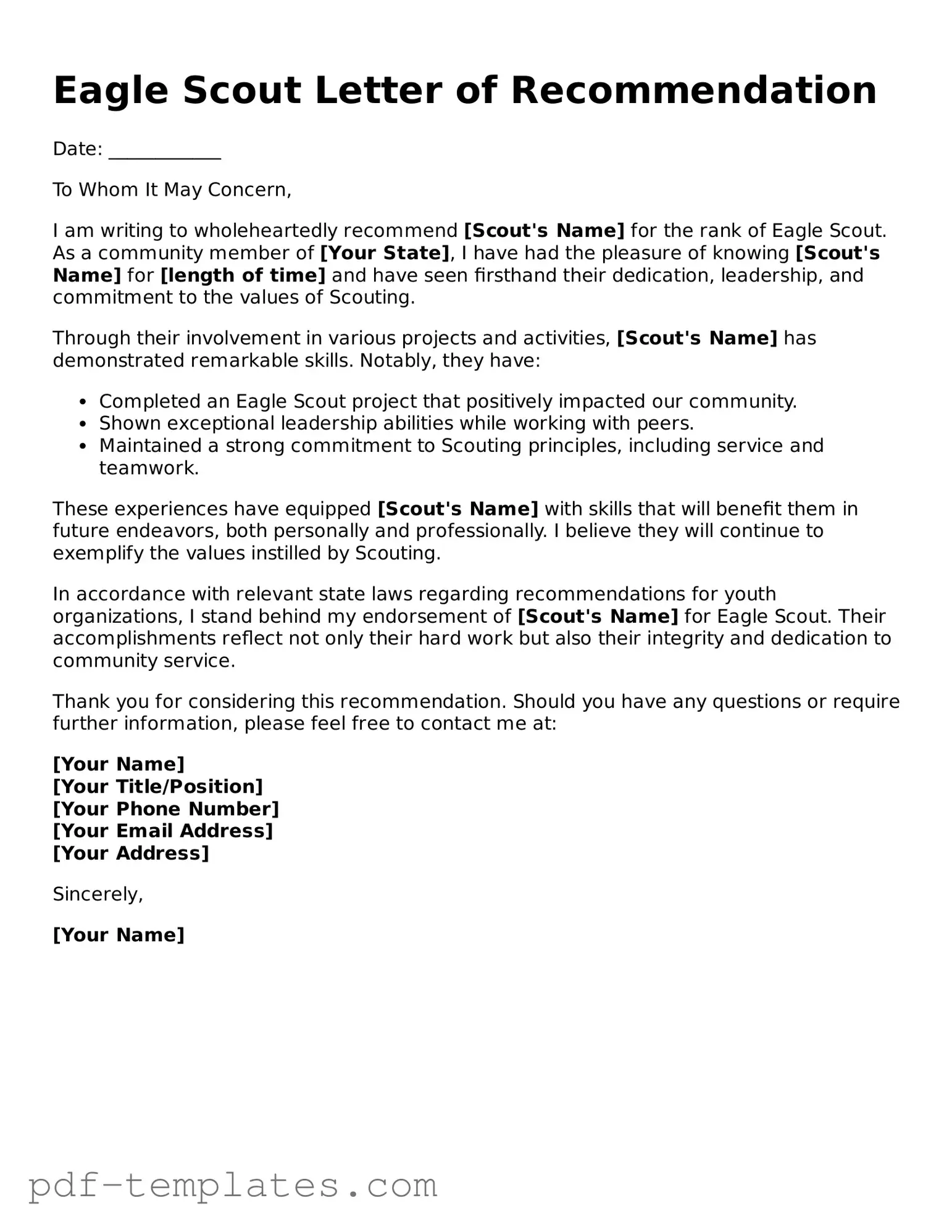The Eagle Scout Letter of Recommendation form shares similarities with the college admission recommendation letter. Both documents serve to provide a personal endorsement of an individual’s character, achievements, and potential. In college admissions, a recommendation letter from a teacher or mentor can significantly influence the decision-making process. Similarly, the Eagle Scout recommendation aims to highlight the scout’s leadership skills, community involvement, and personal integrity, which are crucial for earning the Eagle Scout rank.
Another comparable document is the job reference letter. When applying for a position, candidates often submit references who can vouch for their skills and work ethic. Like the Eagle Scout recommendation, a job reference letter emphasizes the individual’s strengths and contributions, helping to create a well-rounded view of the candidate. Both letters are crucial in portraying the individual positively to an external audience, whether it be a college admissions committee or a potential employer.
The letter of recommendation for graduate school also mirrors the Eagle Scout form. Graduate programs typically require applicants to submit letters from professors or professionals who can speak to their qualifications and readiness for advanced study. In both cases, the recommender provides insights into the individual’s capabilities, work ethic, and accomplishments. This helps the reviewing body make informed decisions based on the applicant’s past performance and potential for future success.
A character reference letter is another document that aligns closely with the Eagle Scout Letter of Recommendation. This type of letter is often used in legal situations, job applications, or community service opportunities. It focuses on the individual’s character traits and personal integrity, much like the Eagle Scout recommendation. Both documents aim to reassure the reader of the individual’s moral standing and commitment to their community.
The letter of recommendation for a scholarship application shares a similar purpose. Scholarship committees often require letters that attest to an applicant's academic achievements and community service. Just as the Eagle Scout recommendation highlights a scout’s dedication and leadership, scholarship letters emphasize the applicant’s qualifications and potential for success. Both documents play a pivotal role in securing opportunities for the individual.
Another related document is the mentorship recommendation letter. In mentorship programs, mentors often provide letters that speak to the mentee’s growth and potential. These letters, like the Eagle Scout recommendation, emphasize personal development, leadership, and the impact of the individual’s contributions. Both documents aim to showcase the individual’s journey and the value they bring to a community or organization.
The reference letter for a volunteer position also bears similarities to the Eagle Scout recommendation. Organizations often seek references for volunteers to ensure they align with the group’s values and mission. This type of letter highlights the individual’s commitment to service and their ability to work well with others. Both documents serve to validate the individual’s character and contributions to their community.
When discussing important supportive documents like the Eagle Scout Letter of Recommendation and its various parallels, it's vital to also consider the role of a Character Reference Letter for Child Custody, which can similarly provide valuable insights into an individual's suitability as a guardian. A well-crafted letter for this purpose speaks volumes about the individual’s qualities and capabilities, serving to emphasize their dedication and stability in a custody case. For those seeking assistance in crafting such letters, resources like smarttemplates.net can be incredibly helpful in ensuring that the letter made serves its purpose effectively.
The letter of recommendation for an internship is another document that parallels the Eagle Scout recommendation. Internships often require candidates to provide references who can speak to their skills and work ethic. Like the Eagle Scout letter, this recommendation focuses on the individual’s potential and readiness to take on new challenges. Both letters are vital in establishing credibility and demonstrating the individual’s qualifications for the opportunity.
Finally, the letter of support for a community project resembles the Eagle Scout recommendation in its purpose. Community projects often require letters of support to demonstrate the backing of local leaders or organizations. These letters highlight the individual’s contributions and commitment to improving their community. Both documents aim to foster trust and confidence in the individual’s ability to make a positive impact.
